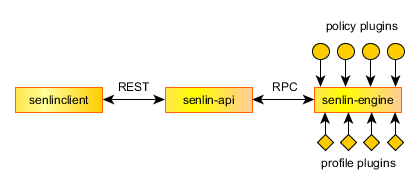Difference between revisions of "Senlin"
(→Architecture) |
(→Senlin) |
||
| Line 27: | Line 27: | ||
* The ''senlin-engine'' service sits behind the ''senlin-api'' service and operates on the clusters/nodes, using ''profiles'' and ''policies'' that are loaded as plugins. | * The ''senlin-engine'' service sits behind the ''senlin-api'' service and operates on the clusters/nodes, using ''profiles'' and ''policies'' that are loaded as plugins. | ||
| − | = Senlin | + | == Terms == |
| + | ===== ¤ Cluster ===== | ||
| + | Senlin provides a clustering service to create and manage objects of the same nature, e.g. Nova servers, Heat stacks, Cinder volumes, etc. The collection of these objects is referred to as a ''cluster''. | ||
| − | + | ===== ¤ Nodes ===== | |
| + | Senlin abstracts the physical objects as ''nodes'', which can belong to any cluster of the same ''profile type''. | ||
| − | + | ===== ¤ Profiles ===== | |
| + | Senlin supports object creation, deletion and update via a concept called ''Profile''. Each profile is in essential a driver to communicate with certain services for object manipulation. | ||
| + | [[senlin-profiles.png]] | ||
| − | + | ===== ¤ Policies ===== | |
| − | + | With Senlin, user can attach a ''policy'' to a cluster and enforce it, or detach it from a cluster. Some built-in policies are provided to meet requirements such as auto-scaling, load-balancing, high-availability etc. | |
| − | == | + | [[senlin-policies.png]] |
| − | |||
| − | |||
| − | |||
| − | |||
| − | |||
| − | |||
| − | |||
| − | |||
| − | |||
| − | |||
| − | |||
| − | |||
| − | |||
| − | |||
| − | |||
| − | |||
| − | |||
| − | |||
| − | |||
| − | |||
| − | |||
| − | |||
| − | |||
| − | |||
| − | |||
| − | |||
| − | |||
| − | |||
| − | |||
| − | |||
= Get involved = | = Get involved = | ||
Revision as of 15:33, 29 June 2015
Overview
The mission of the Senlin project is to provide a generic clustering service for an OpenStack cloud. Such a service is capable of managing the homogeneous objects exposed by other OpenStack components, such as Nova, Heat, Cinder etc.
Features Highlight
The primary features of the Senlin service are listed below:
- A generic clustering/collection service for managing groups of homogeneous cloud objects on OpenStack.
- A set of APIs for managing cluster membership, e.g. add/remove nodes.
- A plugin-based object profile management enabling the creation and management of any object pools.
- A plugin-based policy enforcement framework featuring flexible policy customization for cluster management.
- A asynchronous execution engine for ensuring the state consistency of clusters and nodes.
- A open design for action execution that can be extended to accommodate complex application deployment.
Architecture
The following picture depicts the high-level system architecture of the Senlin service:
The main components in the picture are:
- The senlinclient component provides the command line interface (CLI) for users to interact with the Senlin service;
- The senlin-api service provides the RESTful APIs for the senlinclient component or other services;
- The senlin-engine service sits behind the senlin-api service and operates on the clusters/nodes, using profiles and policies that are loaded as plugins.
Terms
¤ Cluster
Senlin provides a clustering service to create and manage objects of the same nature, e.g. Nova servers, Heat stacks, Cinder volumes, etc. The collection of these objects is referred to as a cluster.
¤ Nodes
Senlin abstracts the physical objects as nodes, which can belong to any cluster of the same profile type.
¤ Profiles
Senlin supports object creation, deletion and update via a concept called Profile. Each profile is in essential a driver to communicate with certain services for object manipulation. senlin-profiles.png
¤ Policies
With Senlin, user can attach a policy to a cluster and enforce it, or detach it from a cluster. Some built-in policies are provided to meet requirements such as auto-scaling, load-balancing, high-availability etc. senlin-policies.png
Get involved
IRC
The developers use IRC in #senlin on Freenode for development discussion.
Meetings
[TBD]
Mailing list
Discussions about Senlin happens on the openstack-dev mailing list.
Please use the tag [Senlin] in the subject line for new threads.

